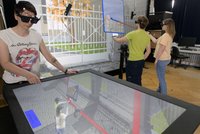
Interactive 3D Visualization in Multi-User Virtual Reality
from Virtuelle Realität
Click the Play button to load and view external content from Vimeo.com.
Automatically load and view external content from Vimeo.com (You can change this setting at any time via our »Data protection policy«.)
Publications
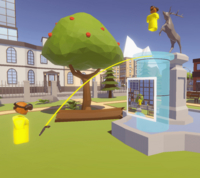
Most prior teleportation techniques in virtual reality are bound to target positions in the vicinity of selectable scene objects. In this paper, we present three adaptations of the classic teleportation metaphor that enable the user to travel to mid-air targets as well.
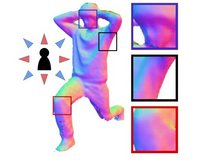
We present and evaluate a system design that enables volumetric avatar reconstruction at increased frame rate, based on a capture configuration with spatio-temporally offset RGBD cameras and a novel reconstruction pipeline.
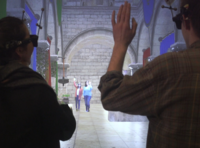
Our novel output-sensitive avatar reconstruction, transmission and rendering approach allows for optimized remote avatar reconstruction, network bandwidth utilization as well as reduced round trip-time between telepresence parties sharing similar perspectives into a shared virtual world.
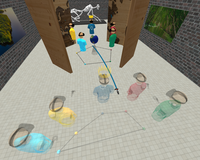
Group navigation techniques should be comprehensible for both the guide and the attendees, assist the group in avoiding collisions with obstacles, and allow the creation of meaningful spatial arrangements with respect to objects of interest. To meet these requirements, we developed a group navigation technique based on short-distance teleportation (jumping) and evaluated it in an initial user study.
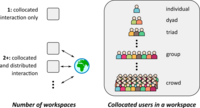
We review the different facets, the resulting challenges, and previous implementations of group navigation in the literature and derive four broad and non-exclusive topic areas for future research on the subject. Our overarching goal is to underline the importance of optimizing navigation processes for groups and to increase the awareness of group navigation techniques as a relevant solution approach in this regard.
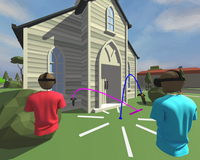
Our group navigation framework for distributed virtual environments suggests that users need to be able to form navigational groups (Forming), distribute navigational responsibilities (Norming), navigate together (Performing), and eventually split up again (Adjourning).
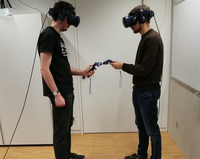
We present a procedure for mapping the tracking data of multiple collocated HTC Vives to a common coordinate system, which enables spatially consistent interactions among all participants.
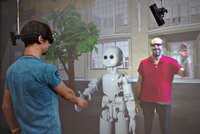
The VR Neurorobotics Lab allows multiple collocated and remote users to experience, discuss and participate in neurorobotic experiments in immersive virtual reality.
Multi-Context Tools enable continuous and conflict-free interaction across multiple independent viewing territories (physical and virtual displays) showing different locations of a shared scene.
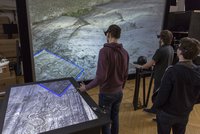
The Collaborative Exploration of Prehistoric Petroglyphs and Their Surrounding Environment in Multi-User Virtual Reality
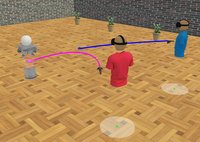
Multi-Ray Jumping is a comprehensible group navigation technique for collocated users wearing head-mounted displays.
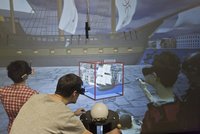
Photoportals build on digital photography as a unifying metaphor for reference-based interaction in 3D virtual environments. Virtual photos and videos serve as three dimensional references to objects, places, moments in time and activities of users.
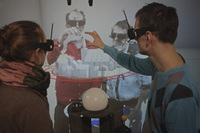
Implementing an immersive telepresence system that allows distributed groups of users to meet in a shared virtual 3D world.
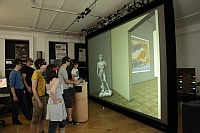
A projection-based stereoscopic display for six users, which employs six customized DLP projectors for fast time-sequential image display in combination with polarization.
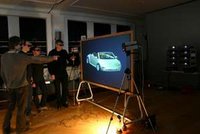
Implementing Multi-Viewer Time-Sequential Stereo Displays Based on Shuttered LCD Projectors
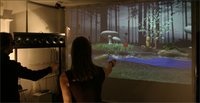
We present a combination of a wave field synthesis system with a multi-viewer stereo display.

We present a method for enabling face-to-face discussions in a novel car interface concept.
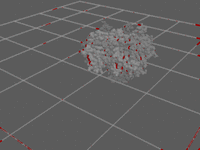
An architecture for smooth motion in virtual environments
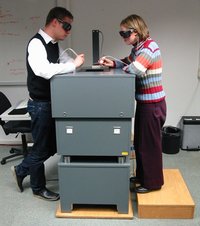
An interactive stereoscopic display system for two or more collocated users
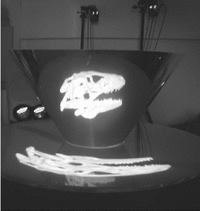
to correct Non-Linear Distortion for Curved Virtual Showcase Displays
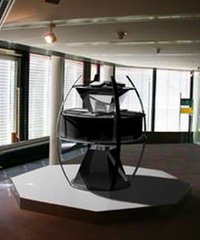
The Virtual Showcase is a novel display device for virtual and augmented reality.
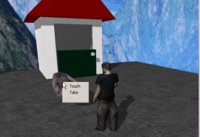
We describe our experiences in the application of the object-capability model for access control to object-manipulation tasks common to collaborative virtual environments.

